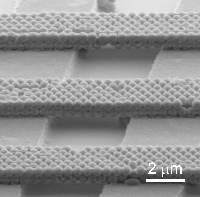
The Twente scientists have developed an entirely new method for building bridges of nanoparticles, using supramolecular forces: gravitational forces between various molecules. These forces cause the nanoparticles, which constitute the bridge, to fall automatically in the right place.
In building the bridges, the researchers use polystyrene spheres of around 500 nanometres in size. They dissolve the spheres in water, and the solution is subsequently deposited into grooves on a surface. The solution evaporates, leaving behind a line of spheres in the groove. The researchers then add to this a ‘supramolecular glue’. This consists of two components: gold particles and so-called dendrimers. These particles adhere to each other and to the polystyrene particles and thus fix the structure. This creates a bar-shaped structure. The bar is then stamped on to a different surface. By stamping the bar on to a grooved surface, the bridge of nanoparticles is created.
The researchers are able to determine all the dimensions of the bridge accurately. The length of the grooves determines the length of the bridge, the breadth of the groove determines the breadth and the speed with which the line is filled determines the thickness (number of layers). In this case, the researchers built bridges of polystyrene and gold particles, but they can also use the method for other materials, such as silica.
According to researchers, we will eventually be able to apply the nano bridges in, among other things, the manufacture of optical filters that allow or disallow specific wave lengths to pass through. Another area of application is microelectronics, where we could use the bridges for minuscule links or sensors.
The research was carried out within the Molecular Nanofabrication Group of Prof. Jurriaan Huskens and the Materials Science and Technology of Polymers Group of Prof. Julius Vancso. Both groups are part of the MESA+ Institute for Nanotechnology at the University of Twente.
The article ‘Freestanding 3D Supramolecular Particle Bridges: Fabrication and Mechanical Behavior’ by Xing Yi Ling, In Yee Phang, Holger Schönherr, David Reinhoudt, Julius Vancso and Jurriaan Huskens is published in the 19 June issue of the leading specialist journal, Small. An image of the bridges is displayed on the cover of the publication.
Ling XY, Phang IY, Schonherr H, Reinhoudt DN, Vansco GJ, Huskens J. (2009) Freestanding 3D Supramolecular Particle Bridges: Fabrication and Mechanical Behavior. Small 5(12):1428-1435. DOI:10.1002/smll.200900068.
Image courtesy of the University of Twente.
